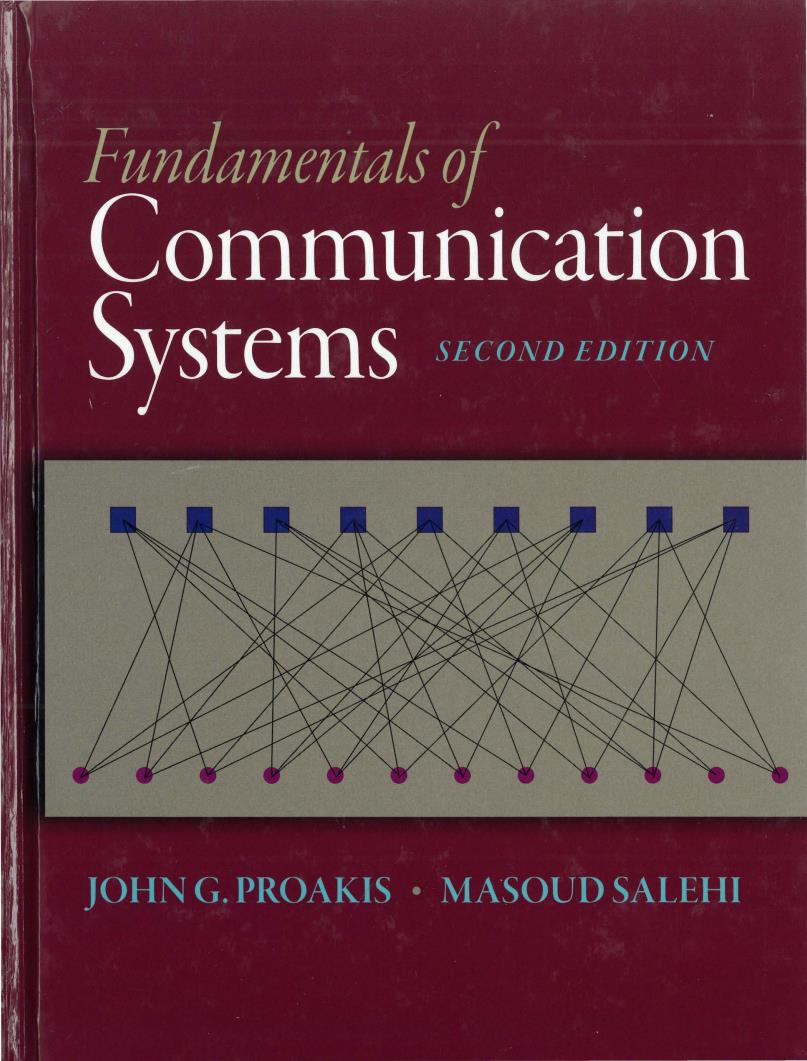
Fundamentals of Communication Systems SECOND EDITION JOHN G.PROAKIS.MASOUD SALEHI
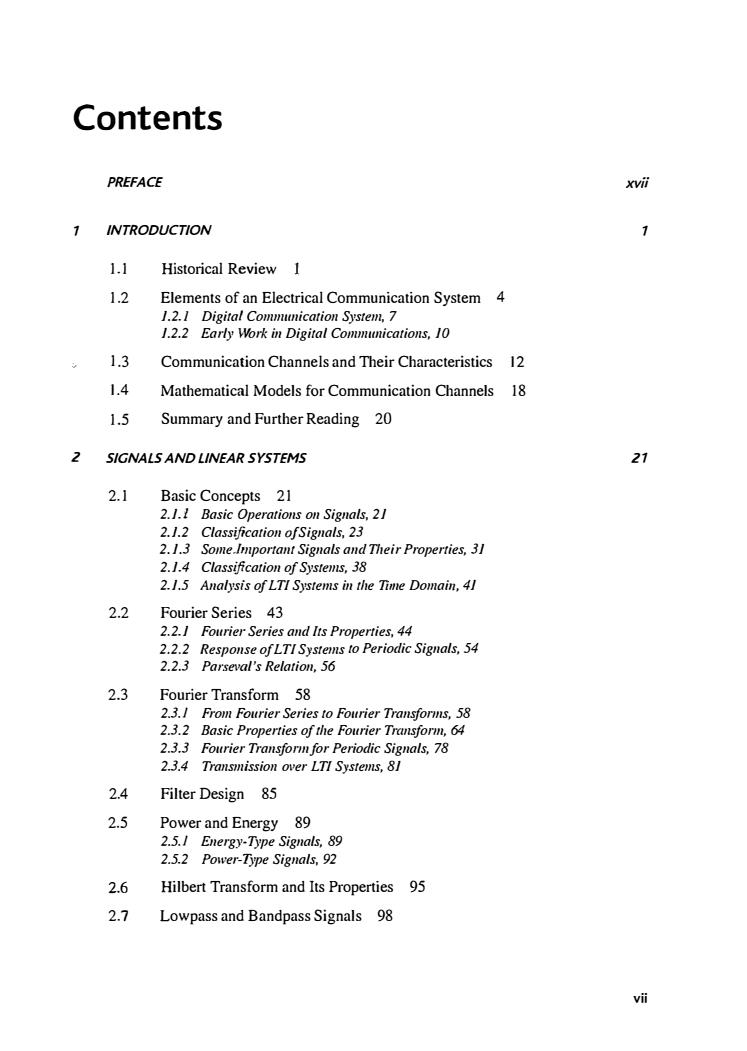
Contents PREFACE xvii 1 INTRODUCTION 1.1 Historical Review I 1.2 Elements of an Electrical Communication System 4 1.2.1 Digital Communication System,7 1.2.2 Early Work in Digital Communications,10 1.3 Communication Channels and Their Characteristics 12 1.4 Mathematical Models for Communication Channels 18 1.5 Summary and Further Reading 20 2 SIGNALS AND LINEAR SYSTEMS 21 2.1 Basic Concepts 21 2.1.1 Basic Operations on Signals,21 2.1.2 Classification ofSignals,23 2.1.3 Some.Important Signals and Their Properties,31 2.1.4 Classification of Systems,38 2.1.5 Analysis of LTI Systems in the Time Domain,41 2.2 Fourier Series 43 2.2.1 Fourier Series and Its Properties,44 2.2.2 Response ofLTI Systemns to Periodic Signals,54 2.2.3 Parseval's Relation,56 2.3 Fourier Transform 58 2.3.1 From Fourier Series to Fourier Transforins,58 2.3.2 Basic Properties of the Fourier Transform,64 2.3.3 Fourier Transforin for Periodic Signals,78 2.3.4 Transmission over LTI Systems,81 2.4 Filter Design 85 2.5 Power and Energy 89 2.5.1 Energy-Type Signals,89 2.5.2 Power-Type Signals,92 2.6 Hilbert Transform and Its Properties 95 2.7 Lowpass and Bandpass Signals 98 vii
Contents 1 2 PREFACE INTRODUCTION 1.1 Historical Review 1.2 Elements of an Electrical Communication System 4 1.2.J Digital Co111111unicatio11 Syste111, 7 1.2.2 Early YVork in Digital Con1111u11icatio11s, 10 1.3 Communication Channels and Their Characteristics 12 1.4 Mathematical Models for Communication Channels 18 1.5 Summary and Further Reading 20 SIGNALS AND LINEAR SYSTEMS 2.1 Basic Concepts 21 2.1.l Basic Operations on Signals, 21 2.1.2 Classification a/Signals, 23 2.1.3 Son1eJ111portant Signals and Their Properties, 31 2.1.4 Classification of Syste111s, 38 2.1.5 Analysis of LT! Systen1s in the Tbne Do111ai11, 41 2.2 Fourier Series 43 2.2.1 Fourier Series and Its Properties, 44 2.2.2 Response of LT! Syste111s to Periodic Signals, 54 2.2.3 Parseval's Relation, 56 2.3 Fourier Transform 58 2.3.l Fro111 Fourier Series to Fourier Transfonns, 58 2.3.2 Basic Properties of the Fourier Trcu1sfonn, 64 2.3.3 Fourier Transfonn for Periodic Signals, 78 2.3.4 Tra11s111issio11 over LT! Syste111s, 81 2.4 Filter Design 85 2.5 Power and Energy 89 2.5.l Energ_v-Type Signals, 89 2.5.2 Power-Type Signals, 92 2.6 Hilbert Transform and Its Properties 95 2.7 Lowpass and Bandpass Signals 98 xvii 1 21 vii
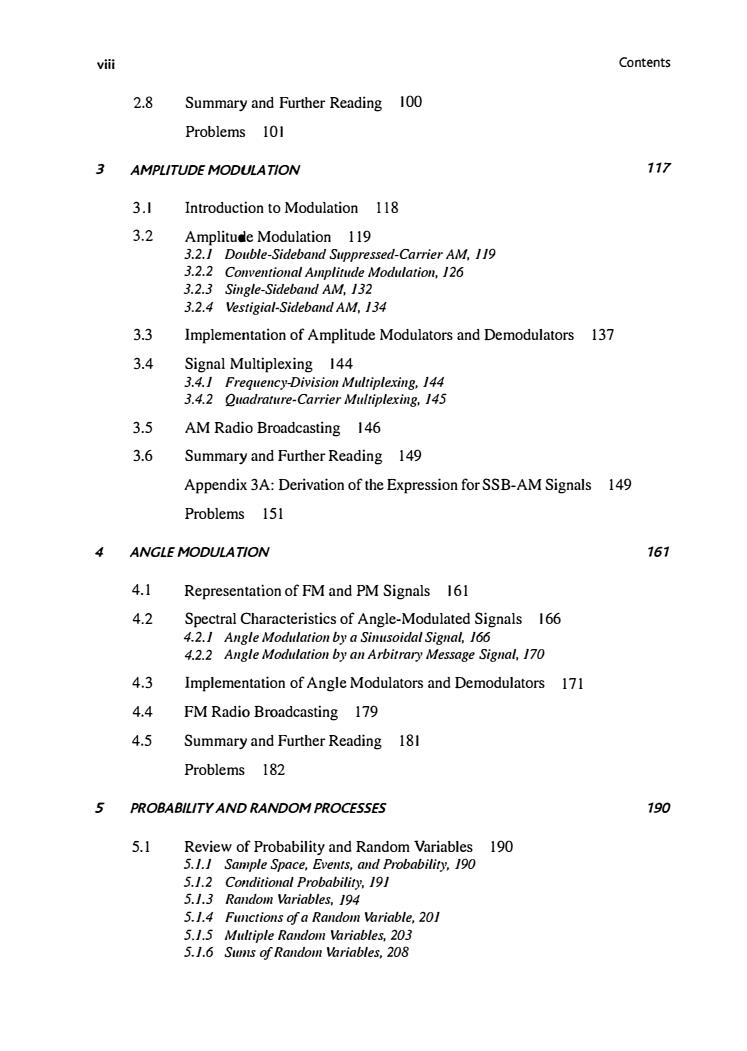
viii Contents 2.8 Summary and Further Reading 100 Problems 101 3 AMPLITUDE MODULATION 117 3.1 Introduction to Modulation 118 3.2 Amplitude Modulation 119 3.2.1 Double-Sideband Suppressed-Carrier AM,119 3.2.2 Conventional Amplitude Modulation,126 3.2.3 Single-Sideband AM,132 3.2.4 Vestigial-Sideband AM,134 3.3 Implementation of Amplitude Modulators and Demodulators 137 3.4 Signal Multiplexing 144 3.4.1 Frequency-Division Multiplexing,144 3.4.2 Quadrature-Carrier Multiplexing,145 3.5 AM Radio Broadcasting 146 3.6 Summary and Further Reading 149 Appendix 3A:Derivation of the Expression for SSB-AM Signals 149 Problems 151 ANGLE MODULATION 161 4.1 Representation of FM and PM Signals 161 4.2 Spectral Characteristics of Angle-Modulated Signals 166 4.2.1 Angle Modulation by a Sinusoidal Signal,166 4.2.2 Angle Modulation by an Arbitrary Message Signal,170 4.3 Implementation of Angle Modulators and Demodulators 171 4.4 FM Radio Broadcasting 179 4.5 Summary and Further Reading 181 Problems 182 5 PROBABILITY AND RANDOM PROCESSES 190 5.1 Review of Probability and Random Variables 190 5.1.1 Sample Space,Events,and Probability,190 5.1.2 Conditional Probability,191 5.1.3 Random Variables,194 5.1.4 Functions of a Randomn Variable,201 5.1.5 Multiple Random Variables,203 5.1.6 Sums of Random Variables,208
viii 3 4 5 Contents 2.8 Summary and Further Reading 100 Problems 10 1 AMPLITUDE MODULA T/ON 3.1 Introduction to Modulation 118 3.2 Amplitude Modulation 119 3.2.1 Double-Sideband Suppressed-Carrier AM, 119 3.2.2 Conventional A111plitude Modulation, 126 3.2.3 Single-Sideband AM, 132 3.2.4 Vestigial-Sideband AM, 134 3.3 Implementation of Amplitude Modulators and Demodulators 137 3.4 Signal Multiplexing 144 3.4.1 Frequency-Division Multiplexing, 144 3.4.2 Quadrature-Carrier M11/tiplexi11g, 145 3.5 AM Radio Broadcasting 146 3.6 Summary and Further Reading 149 Appendix 3A: Derivation of the Expression for SSB-AM Signals 149 Problems 151 ANGLE MODULATION 4.1 Representation of FM and PM Signals 161 4.2 Spectral Characteristics of Angle-Modulated Signals 166 4.2.1 Angle Modulation by a Sinusoidal Signal, 166 4.2.2 Angle Modulation by an Arbitra1y Message Signal, 170 4.3 Implementation of Angle Modulators and Demodulators 171 4.4 FM Radio Broadcasting 179 4.5 Summary and Further Reading 181 Problems 182 PROBABILITY AND RANDOM PROCESSES 5.1 Review of Probability and Random Variables 190 5.1.1 Sa111ple Space, Events, and P1vbability, 190 5.1.2 Conditional Probability, 191 5.1.3 Rando111 Variables, 194 5.1.4 Functions of a Ra11do111 Variable, 201 5.1.5 Multiple Rando111 Variables, 203 5.1.6 Sun1s of Ra11do111 Variables, 208 117 161 190
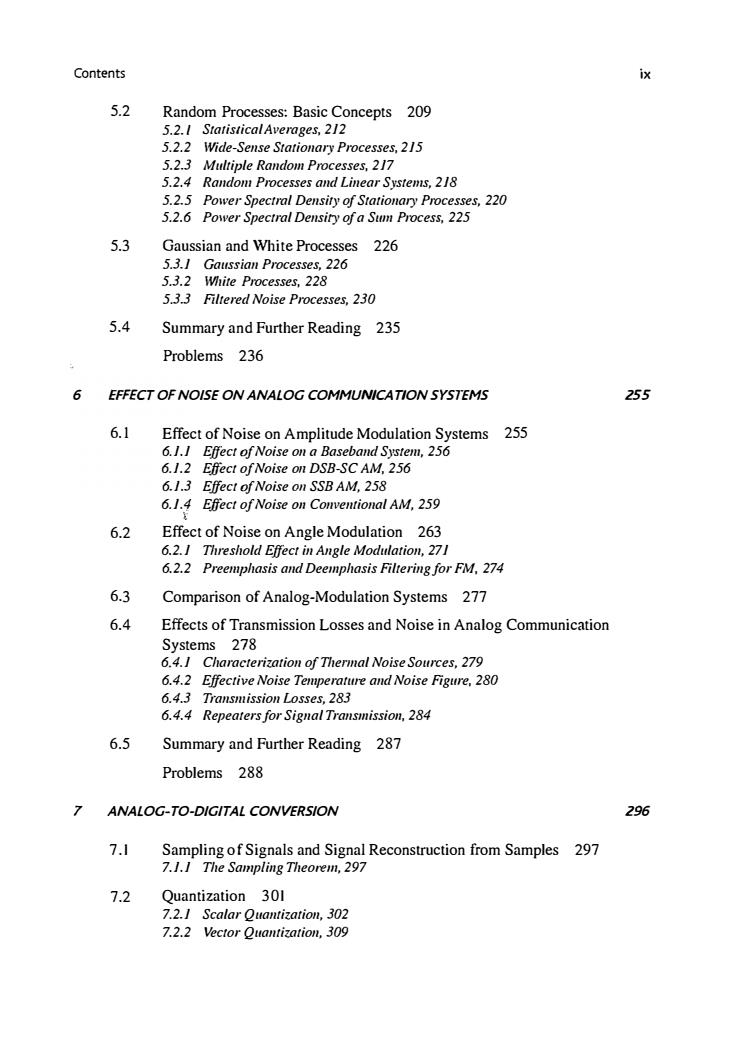
Contents ix 5.2 Random Processes:Basic Concepts 209 5.2.1 StatisticalAverages,212 5.2.2 Wide-Sense Stationary Processes,215 5.2.3 Multiple Random Processes,217 5.2.4 Random Processes and Linear Systems,218 5.2.5 Power Spectral Density of Stationary Processes,220 5.2.6 Power Spectral Densiry of a Sum Process,225 5.3 Gaussian and White Processes 226 5.3.1 Gaussian Processes,226 5.3.2 White Processes,228 5.3.3 Filtered Noise Processes,230 5.4 Summary and Further Reading 235 Problems 236 EFFECT OF NOISE ON ANALOG COMMUNICATION SYSTEMS 255 6.1 Effect of Noise on Amplitude Modulation Systems 255 6.1.1 Effect of Noise on a Baseband System,256 6.1.2 Effect of Noise on DSB-SC AM,256 6.1.3 Effect of Noise on SSB AM,258 6.1.4 Effect of Noise on Conventional AM,259 6.2 Effect of Noise on Angle Modulation 263 6.2.I Threshold Effect in Angle Modulation,271 6.2.2 Preemphasis and Deemphasis Filtering for FM,274 6.3 Comparison of Analog-Modulation Systems 277 6.4 Effects of Transmission Losses and Noise in Analog Communication Systems 278 6.4.1 Characterization of Thermal Noise Sources,279 6.4.2 Effective Noise Temperature and Noise Figure,280 6.4.3 Transmission Losses,283 6.4.4 Repeaters for Signal Transmission,284 6.5 Summary and Further Reading 287 Problems 288 ANALOG-TO-DIGITAL CONVERSION 296 7.1 Sampling of Signals and Signal Reconstruction from Samples 297 7.1.1 The Sampling Theorem,297 7.2 Quantization 301 7.2.1 Scalar Quantization,302 7.2.2 Vector Quantization,309
Contents 6 7 5.2 Random Processes: Basic Concepts 209 5.2.l Stalistical Averages, 212 5.2.2 Wide-Sense Stationary Processes, 215 5.2.3 Multiple Rando111 Processes, 217 5.2.4 Ra11don1 Processes and linear Syste111s, 218 5.2.5 Power Spectral Densily of Stationa1y P1vcesses, 220 5.2.6 Power Spectral Density of a Su111 P1vcess, 225 5.3 Gaussian and White Processes 226 5.3.1 Gaussian Processes, 226 5.3.2 White P1vcesses, 228 5.3.3 Filtered Noise Processes, 230 5.4 Summary and Further Reading 235 Problems 236 EFFECT OF NOISE ON ANALOG COMMUN/CATION SYSTEMS 6.1 Effect of Noise on Amplitude Modulation Systems 255 6.1.1 Effect of Noise on a Baseband Systen1, 256 6.1.2 Effect of Noise oil DSB-SC AM, 256 6.1.3 Effect of Noise Oil SSB AM, 258 6.1.4 Effect of Noise 011 Conventional AM, 259 6.2 Effect of Noise on Angle Modulation 263 6.2. 1 Threshold Effect in Angle Modulation, 271 6.2.2 Preen1phasis and Dee111phasis Filtering for FM, 274 6.3 Comparison of Analog-Modulation Systems 277 6.4 Effects of Transmission Losses and Noise in Analog Communication Systems 278 6.4.1 Characterization ofThennal Noise Sources, 279 6.4.2 Effective Noise Ten1perature and Noise Figure, 280 6.4.3 Ttansnzission losses, 283 6.4.4 Repeaters for Signal Trans111issio11, 284 6.5 Summary and Further Reading 287 Problems 288 ANALOG-TO-DIGITAL CONVERSION 7.1 Sampling of Signals and Signal Reconstruction from Samples 297 7.1.1 The Sa111pli11g Theore111, 297 7.2 Quantization 301 7.2.1 Scalar Quantization, 302 7.2.2 Vector Quantization, 309 ix 255 296
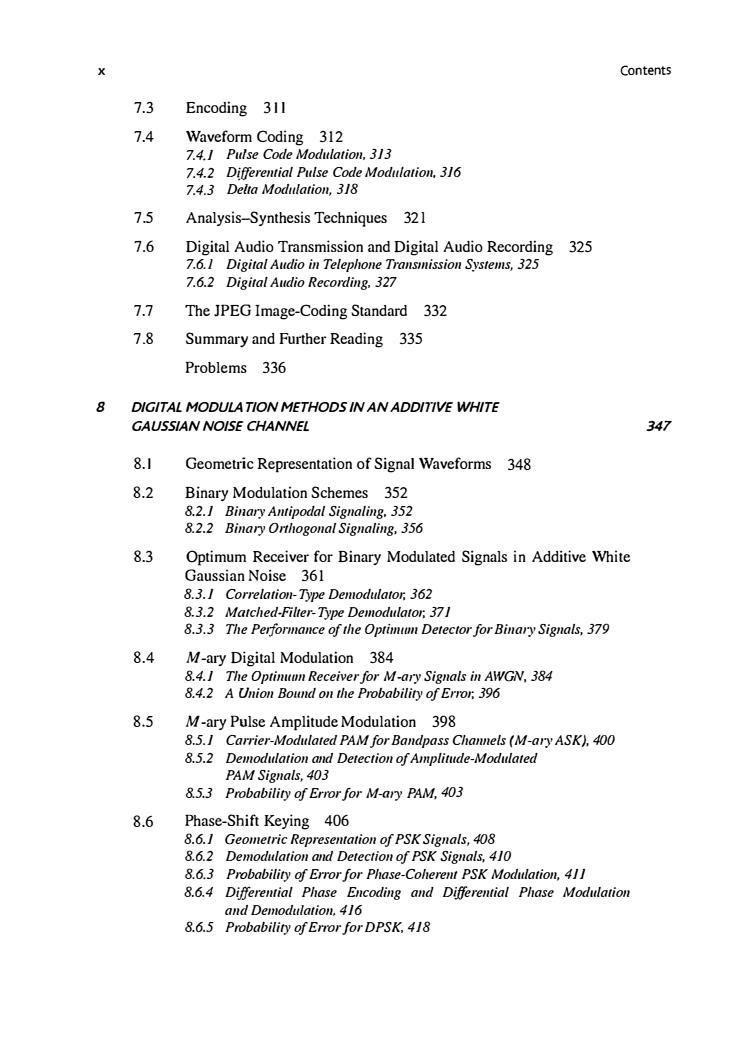
Contents 7.3 Encoding 311 7.4 Waveform Coding 312 7.4.1 Pulse Code Modulation,313 7.4.2 Differential Pulse Code Modulation,316 7.4.3 Delta Modulation,318 7.5 Analysis-Synthesis Techniques 321 7.6 Digital Audio Transmission and Digital Audio Recording 325 7.6.1 Digital Audio in Telephone Transiission Systems,325 7.6.2 Digital Audio Recording,327 7.7 The JPEG Image-Coding Standard 332 7.8 Summary and Further Reading 335 Problems 336 8 DIGITAL MODULATION METHODS IN AN ADDITIVE WHITE GAUSSIAN NOISE CHANNEL 347 8.1 Geometric Representation of Signal Waveforms 348 8.2 Binary Modulation Schemes 352 8.2.1 Binary Antipodal Signaling.352 8.2.2 Binary Orthogonal Signaling,356 8.3 Optimum Receiver for Binary Modulated Signals in Additive White Gaussian Noise 361 8.3.1 Correlation-Type Demodulator,362 8.3.2 Matched-Filter-Type Demodulator;371 8.3.3 The Performance of the Optimiun Detector for Binary Signals,379 8.4 M-ary Digital Modulation 384 8.4.1 The Optinuun Receiver for M-ary Signals in AWGN,384 8.4.2 A Union Bound on the Probabiliry of Error;396 8.5 M-ary Pulse Amplitude Modulation 398 8.5.1 Carrier-Modulated PAM for Bandpass Channels (M-ary ASK),400 8.5.2 Demodulation and Detection of Amplitude-Modulated PAM Signals,403 8.5.3 Probability of Error for M-ary PAM,403 8.6 Phase-Shift Keying 406 8.6.1 Geometric Representation of PSK Signals,408 8.6.2 Demodulation and Detection of PSK Signals,410 8.6.3 Probability of Error for Phase-Coherent PSK Modulation,411 8.6.4 Differential Phase Encoding and Differential Phase Modulation and Demodulation.416 8.6.5 Probability of Error for DPSK,418
x Contents 7.3 Encoding 31 l 7.4 Waveform Coding 312 7.4.1 Pulse Code Modulation, 313 7.4.2 Differential Pulse Code Mod11/atio11, 316 7.4.3 Delta Mod11!ation, 318 7 .5 Analysis-Synthesis Techniques 32 l 7 .6 Digital Audio Transmission and Digital Audio Recording 325 7.6. J Digital Audio in Telephone Tra11s111issio11 S.vste111s, 325 7.6.2 Digital Audio Recording, 327 7.7 The JPEG Image-Coding Standard 332 7 .8 Summary and Further Reading 335 Problems 336 8 DIGITAL MODULATION METHODS IN AN ADDITIVE WHITE GAUSSIAN NOISE CHANNEL 8.1 Geometric Representation of Signal Waveforms 348 8.2 Binary Modulation Schemes 352 8.2. 1 Billa I)' Antipodal Signaling, 352 8.2.2 Binary Orthogonal Signaling, 356 8.3 Optimum Receiver for Binary Modulated Signals in Additive White Gaussian Noise 361 8.3.1 Correlation-Type Den1odt1lato1; 362 8.3.2 Matched-Filter-Type De111odulato1; 371 8.3.3 The Pe1fonna11ce of the Optb1111111 Detector for Bina/)' Signals, 379 8.4 M-ary Digital Modulation 384 8.4.1 The Optinu11n Receiver for M-aJ)' Signals in A W GN, 384 8.4.2 A Union BoHnd 011 the P1vbability of Env1; 396 8.5 M -ary Pulse Amplitude Modulation 398 8.5. 1 Carrier-Modulated PAM for Bandpass Channels ( M-al)' ASK), 400 8.5.2 De1nodulation and Detection of A111plitude-Modulated PAM Signals, 403 8.5.3 Probability of Error/or M-my PAM, 403 8.6 Phase-Shift Keying 406 8.6.1 Geo111etric Representation of PSK Signals, 408 8.6.2 Den1odHlation and DetecNon of PSK Signals, 410 8.6.3 Probability of Error/or Phase-Coherent PSK Modulation, 411 8.6.4 Differential Phase Encoding and Differential Phase Modulation and De111odI1!ation, 416 8.6.5 Probability of Error/or D PSK, 418 347